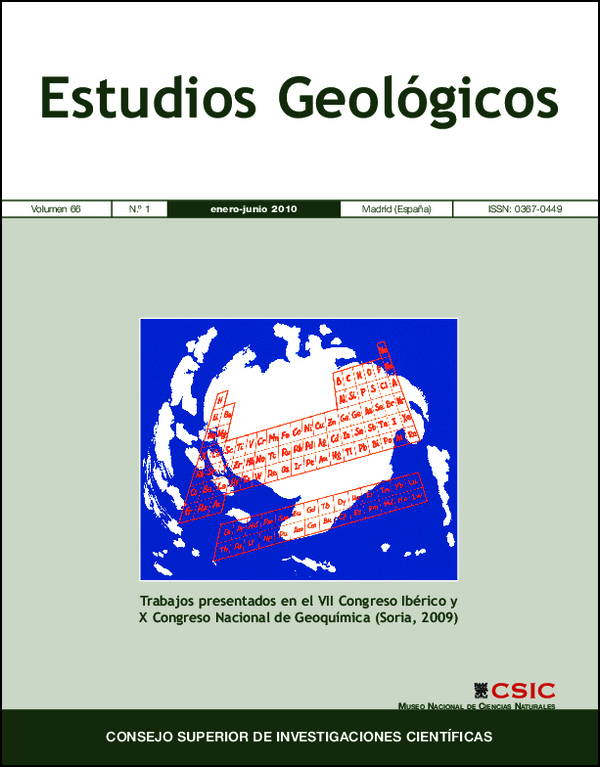New petrographic, geochemical and geochronological data for the Reguengos de Monsaraz pluton (Ossa Morena Zone, SW Iberian Massif, Portugal)
DOI:
https://doi.org/10.3989/egeol.40162.123Keywords:
Ossa Morena Zone, late to post tectonic intrusion, calc-alkaline magmas, mingling/mixing, Rb-Sr geochronologyAbstract
The Reguengos de Monsaraz pluton is a late to post-tectonic Variscan intrusion occurring in the Ossa Morena Zone (Iberian Variscan Chain). The dominant lithological types are tonalites and granodiorites, but the internal area of the massif is composed of gabbro-dioritic rocks. Field evidence shows that the intrusion is heterogeneous at mesoscopic scale suggesting that the emplacement of mafic and felsic magmas was contemporaneous. Petrographic and geochemical studies reveal that the different lithologic types define a continuous sequence with compositions varying from metaluminous to slightly peraluminous and a typical calc-alkaline signature. In Harker variation diagrams, it is possible to observe systematic rectilinear correlations pointing to the involvement of magma mingling/mixing processes in the petrogenesis of this sequence. Rb-Sr isotopic data, using a mineral-mineral pair from a granodiorite sample, yielded an age of 298 Ma, interpreted as a cooling age after igneous crystallization.
Downloads
References
Araújo, A.; Piçarra Almeida, J.; Borrego, J.; Pedro, J. & Oliveira, T. (2006). As regiões central e sul da Zona de Ossa Morena. In: Geologia de Portugal no Contexto da Ibéria (Dias, R.; Araújo, A.; Terrinha, P. & Kullberg, J.C., eds.), Universidade de Évora, 151-172.
Barbarin, B. (1990). Plagioclase xenocrysts and mafic magmatic enclaves in some granitoids of the Sierra Nevada batholith, California. Journal of Geophysical Research, 95: 17747-17756. doi:10.1029/JB095iB11p17747
Carvalhosa, A. (1967). Notícia Explicativa da Folha 40-D (Portel) da Carta Geológica de Portugal, na escala 1:50 000. Serv. Geol. de Portugal, Lisboa, 24 pp.
Carvalhosa, A. & Zbyzewski, G. (1991). Notícia Explicativa da Folha 40-B (Reguengos de Monsaraz) da Carta Geológica de Portugal, na escala 1:50000. Serviços Geologicos de Portugal, Lisboa, 51 pp.
Evensen, N.H.; Hamilton, P.J. & O’Nions, R.K. (1978). Rare earth abundances in chondrite meteorites. Geochimica et Cosmochimica Acta, 42: 1199-1212. doi:10.1016/0016-7037(78)90114-X
La Roche, H.; Leterrier, J.; Granclaude, P. & Marchal, M. (1980). A classification of volcanic and plutonic rocks using R1-R2 diagram and major elements analysis. Chemical Geology, 29: 183-210. doi:10.1016/0009-2541(80)90020-0
Mendes, F. (1967-68) Contribuition à l’étude geochronologique par la méthode du strontium des formations cristalines du Portugal. Boletin do Museu e Laboratório Mineralógico e Geológico da Faculdade de Ciências- Universidade de Lisboa, 2: 3-157.
Oliveira, J.T.; Oliveira, V. & Piçarra, J.M. (1991). Traços gerais da evolução tectono-estratigráfica da Zona de Ossa Morena em Portugal: síntese crítica do estado actual dos conhecimentos. Comunicações dos Serviços Geológicos de Portugal, 77: 3-26.
Pinto, M.S. (1984). Granitóides caledónicos e hercínicos na Zona de Ossa Morena (Portugal)- nota sobre aspectos geocronológicos. Memórias e Notícias, Publicações do Museu e Laboratório Mineralógico e Geológico da Universidade de Coimbra, 97: 81-94.
Pitcher, W.S. (1993). The nature and origin of granite. Chapman & Hall, London, 321 pp.
Silva, M.M.V.G. & Pinto, M.M.S.C. (2006). Geoquímica das rochas ígneas do plutão de Reguengos de Monsaraz (Alto Alentejo). Livro de resumos do VII Congresso Nacional de Geologia, 1: 249-251.
Sun, S. & Mc Donough, W.F. (1989). Chemical and isotopic systematics of oceanic basalts: implications for mantle composition and processes. In: Magmatism in the Ocean Basins (Saunders, A.D. & Norry, M.J., eds.). Geological Society of London Special Publications, London, 42: 313-345.
Vernon, R.H. (1990). Crystallization and hybridism in microgranitoid enclave magmas: microstructural evidence. Journal of Geophysical Research, 95: 17849-17859. doi:10.1029/JB095iB11p17849
Downloads
Published
How to Cite
Issue
Section
License
Copyright (c) 2010 Consejo Superior de Investigaciones Científicas (CSIC)

This work is licensed under a Creative Commons Attribution 4.0 International License.
© CSIC. Manuscripts published in both the print and online versions of this journal are the property of the Consejo Superior de Investigaciones Científicas, and quoting this source is a requirement for any partial or full reproduction.
All contents of this electronic edition, except where otherwise noted, are distributed under a Creative Commons Attribution 4.0 International (CC BY 4.0) licence. You may read the basic information and the legal text of the licence. The indication of the CC BY 4.0 licence must be expressly stated in this way when necessary.
Self-archiving in repositories, personal webpages or similar, of any version other than the final version of the work produced by the publisher, is not allowed.















